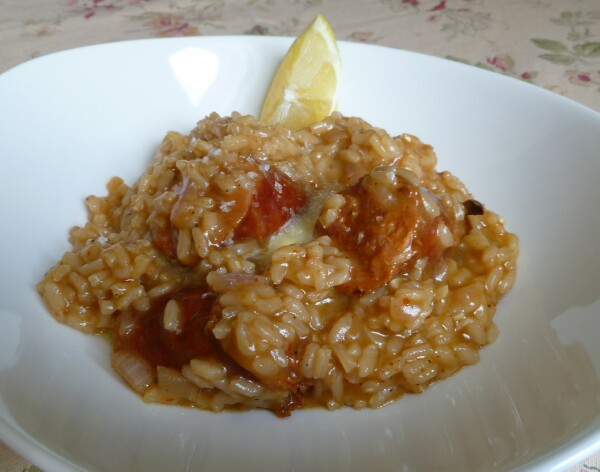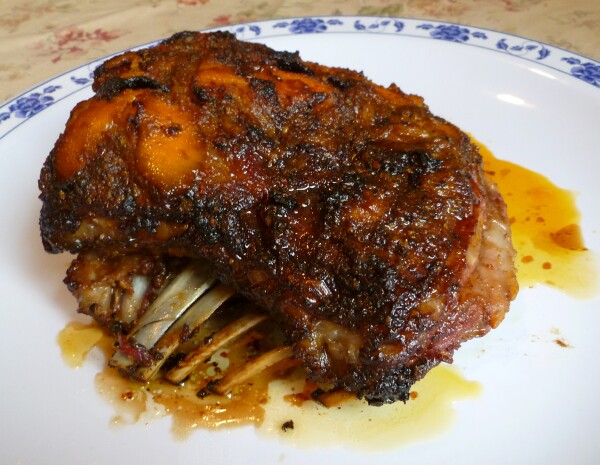Risotto: Crunchy vs Al Dente
Risotto: Crunchy vs Al Dente
-
-
-
-
-
Risotto: Crunchy vs Al Dente
-
Post #1 - April 6th, 2007, 9:54 pmI have read/seen many recipes for risotto. They generally call for the rice to be cooked with some wine, once that is absorbed, to finish by slowly adding warm broth a little at a time, cooking until it is absorbed, add more broth, repeat.
I know they say the rice should be 'al dente,' a term I am very comfortable with regarding pasta. However, when making risotto, after using up the maximum amount of liquid, the rice seems more crunchy than al dente.
I went out tonight at an Italian restaurant and had risotto for the first time in a long time at a restaurant. It was also crunchy.
So is al dente rice supposed to have a little crunch? Is that what is considered al dente, or have my attempts at home and at the restaurant tonight both contained too little liquid?
I am ok 'overcooking' it at home if that is my preference, but I just can't see 'crunchy' being the same as 'al dente' even if it is rice. I guess mostly I want to know if crunchy is the norm, then I just won't ever order it out.
Can anyone provide any insight...?
-
-
Post #2 - April 6th, 2007, 9:58 pmI don't believe I've ever had "crunchy" risotto. I like crunch, but if the rosotto is making a crunch, that would seem to be a technical "error"...maybe good in its own way, but not the norm.
Just curious, what restaurant served you the crunchy risotto, if you don't mind my asking?"Don't you ever underestimate the power of a female." Bootsy Collins
-
-
Post #3 - April 6th, 2007, 10:18 pmDavid,
Thanks for the quick reply! It was Figo in downtown St. Charles. It is pretty new (opened Aug 06 where Bistro Thai used to be), and the server was quite generous with information. The 'grandma' comes in daily to make the pastas fresh. DH got the bolognese and the server confirmed it was cooked all day, with the milk, etc... It all sounded on the up & up and very authentic. We got the polpetti di luga as an appetizer, which is basically meatballs with marinara. They were excellent, although the marinara was exceptionally salty. My risotto was the Al Pesce style and it was pretty well packed with fish for the $17 pricetag. But, crunchy.
There is also a Wheaton location.
http://www.figoristorante.com/stcharles/home.htm
I would go back to the place because the things that were good were very good even if the risotto was a miss, but I was just curious if the risotto was underdone or if that truly was 'al dente.'
Thanks for the info!
-
-
Post #4 - April 7th, 2007, 8:14 amMy preference for risotto is that it be a little firm in the middle of the grain (ala al dente) versus mushy throughout. I've had a lot of mushy restaurant risotto over the years.
-
-
Post #5 - April 7th, 2007, 10:49 amYourPalWill wrote:My preference for risotto is that it be a little firm in the middle of the grain (ala al dente) versus mushy throughout. I've had a lot of mushy restaurant risotto over the years.
A real test, to me, of good risotto is if each grain is somewhat distinct. I can't say that's the usual way I get it."Don't you ever underestimate the power of a female." Bootsy Collins
-
-
Post #6 - April 7th, 2007, 12:55 pmI believe (though pehaps we need Antonius to weigh in), that there are regional preferences regarding the overall soupiness. If I remember correctly, they like the finished dish a bit brothier up in the north (Veneto, etc.), and more completely absorbed further south. But in neither case am I aware of a crunch factor being desirable. Just, as previously mentioned, each grain maintaining some integrity as opposed to ending up as rice oatmeal. Indeed, I have always found mushiness a greater danger than crunchiness in ordering risotto out.
As for home cookin', I have almost always found that I needed about 30% more broth to finish the dish than my recipes ask for. Perhaps my flame is always too high, but in any case, I simply build in that margin and things seem to work out fine. (Generally, I'm cooking from either Marcella or Bugialli. Either way, I'm always short on broth if I follow their proportions.)"Strange how potent cheap music is."
-
-
Post #7 - April 7th, 2007, 1:02 pmMy favorite way to make risotto, though not authentic or elegant, is to use short grain brown rice (I like lundbergs). It takes longer, but is much more forgiving. I simply sautee the rice with whatever I am using, usually dried porcini, add 2+ cups of liquid (usually stock) for each cup of rice, cover and cook for 45 minutes. I usually add some romano cheese at the end. The whole grain rice keeps its individual grain better, even if overcooked. Though you dont get the starch rubbing off to make the sauce, using a good stock, along with the romano, makes it quite creamy. I like the added flavor of brown rice, and it is presumably a bit healthier.
-Will
-
-
Post #8 - March 13th, 2011, 9:27 pm
Crunchy risotto does not sound delectable. I prefer a tiny tooth tug in the center of the grain.christine wrote:I went out tonight at an Italian restaurant and had risotto for the first time in a long time at a restaurant. It was also crunchy.
Made an interesting risotto this evening, started off fairly typical, saute onion, garlic board pureed w/salt,
1/2 teaspoon Aleppo pepper, black pepper in olive oil. Add/toast lightly carnaroli, than things went a little sideways, pomegranate molasses with simmering water instead of wine for that first thirsty addition when the grains are most vulnerable. Near the end of cooking flavor started to skew bitter instead of pomegranate sweet/tart, honey brought the risotto back into balance.
Finished with butter and grey salt and just before serving added home smoked Spanish cooking chorizo from Solex
Risotto with pomegranate molasses, Aleppo pepper and smoked Spanish cooking chorizo
Actually pomegranate risotto was the perfect accompaniment to smoked Moroccan spiced lamb breast. I used fresh juice and peel of both orange and lemon, minced habanero, half-sharp paprika and Moroccan spice mix from The Spice House for an overnight marinade.
Smoked Moroccan spice Lamb Breast

Enjoy,
Gary
-
-
Post #9 - March 13th, 2011, 10:19 pmHow funny! I made risotto as well this evening, though mine was more of the traditional variety: asparagus, lemon juice and zest and caramelized shiitake and cremini mushrooms, with a homemade mushroom stock and some leftover white wine as my cooking liquids. Gary, it must have been something in the air

-
-
Post #10 - March 14th, 2011, 12:48 amchristine wrote:I have read/seen many recipes for risotto. They generally call for the rice to be cooked with some wine, once that is absorbed, to finish by slowly adding warm broth a little at a time, cooking until it is absorbed, add more broth, repeat.
I know they say the rice should be 'al dente,' a term I am very comfortable with regarding pasta. However, when making risotto, after using up the maximum amount of liquid, the rice seems more crunchy than al dente.
I have actually made "crunchy risotto" quite unintentionally.
I always made risotto with imported Italian arborio rice. Never a problem.
However, I was out of Arborio and a used a Lundberg short grain rice. After nearly forty minutes, I could not get that rice anywhere close to soft or even al dente.
-
-
Post #11 - March 14th, 2011, 8:27 amThis is kind of scary, but I also made risotto Saturday night.
 I was at a friends house and neither one of us had ever had risotto before. I found a recipe on epicurious and another friend sent me an article on the “Do’s and Don’ts” of proper risotto. I kept a bunch of plastic spoons to constantly taste as it cooked so I could see/feel the progression of the cooking process. I used ½ cup of white wine, and ended up with stock left over, and my flame never went above medium heat, and the risotto turned out great, at least from the perspective of someone that’s never had it. No crunch, but still firm!! At some point I"m going to have to order it from a restaurant to see what theirs tastes like.
The most dangerous food to eat is wedding cake.
I was at a friends house and neither one of us had ever had risotto before. I found a recipe on epicurious and another friend sent me an article on the “Do’s and Don’ts” of proper risotto. I kept a bunch of plastic spoons to constantly taste as it cooked so I could see/feel the progression of the cooking process. I used ½ cup of white wine, and ended up with stock left over, and my flame never went above medium heat, and the risotto turned out great, at least from the perspective of someone that’s never had it. No crunch, but still firm!! At some point I"m going to have to order it from a restaurant to see what theirs tastes like.
The most dangerous food to eat is wedding cake.
Proverb
-
-
Post #12 - March 14th, 2011, 12:41 pmI agree, I recently made bacon mushroom risotto for the first time and it was great. I used Arborio rice and white white. It was al dente, not crunchy and was very good. I did notice that I had to cook it longer than the recipe said. Once the parmesan is added it "seizes up" a bit and becomes less soupy and more like a rice pudding texture. I actually prefer it that way as I like food I can bite...not a big soupy food fan.Toria
"I like this place and willingly could waste my time in it" - As You Like It,
W. Shakespeare
-
-
Post #13 - March 17th, 2011, 5:45 amI've never heard that risotto should be al dente. The term usually applied is all'onda ("wavy"), which refers to the fluidness of the dish.
-
-
Post #14 - March 17th, 2011, 7:21 amMarcella Hazan does not actually use the word Al Dente, but she says the same thing:The rice is done when it is tender and cooked through, but firm to the bite.
-
-
Post #15 - March 18th, 2011, 10:49 amLAZ wrote:I've never heard that risotto should be al dente. The term usually applied is all'onda ("wavy"), which refers to the fluidness of the dish.
And that's the peril of risotto: not only does the rice need to be the right texture, but also the sauce. Many prefer a thick porridge, natives to Venice prefer it much soupier. If you're making risotto cakes to be toasted later in a pan or oven, obviously you want it stiffer, but a saucy risotto with tender rice -- yes similar to the texture of al dente pasta -- is optimal for eating.
Ordering risotto, though is something I seldom do, since what you end up with is, well, basically a big bowl of porridge. I think a lot of restaurants would move more risotto if they had an accompanying contorno veg.What is patriotism, but the love of good things we ate in our childhood?
-- Lin Yutang
-
-
Post #16 - March 18th, 2011, 11:14 amJoelF wrote:LAZ wrote:I've never heard that risotto should be al dente. The term usually applied is all'onda ("wavy"), which refers to the fluidness of the dish.
And that's the peril of risotto: not only does the rice need to be the right texture, but also the sauce. Many prefer a thick porridge, natives to Venice prefer it much soupier.
My understanding is that the looser Veneto style is properly described as all'onda and often uses Vialone Nano rice, which has less gelatinizable starch (amylopectin) and is thus less creamy and sets up less.
Also, from Cook's Illustrated, May 1, 2008:
"Arborio rice, the classic choice for risotto, contains roughly 19 to 21 percent amylose [the smaller % of this starch, the stickier]. However, that is not the only difference. The desirable "bite" in risotto is due to a defect in Arborio rice called chalk. During maturation, the starch structures at the grain's core deform, making for a firm, toothy center when cooked."
-
-
Post #17 - March 22nd, 2011, 10:54 pmI've been using Carnaroli rice, bought over the Internet from Lotus Foods, with garlic, saffron (not nearly as much as most recipes recommend), white wine (a not-overoaked Chardonnay works well here), chicken stock (usually home-made, but success is good with purchased organic as well), good sweet butter, and hand-shredded Parmegian. Add-ins usually include fresh spinach (thrown in with the last half-cup or so of chicken stock), and mushrooms roasted with thyme, S & P, and olive oil (ditto).
I like a bit of texture without mushiness. A good brut Cava is good to drink with this, and even the good Chard with which it's cooked succeeds.

-
-
Post #18 - August 23rd, 2012, 5:47 pmJust tried carnaroli rice for the first time when making risotto. Very nice. Not that arborio isn't nice, but it's always fun to try something new. It took a bit longer to cook than I expected, but the texture is perfect -- or at least to my taste: rice a little on the firm side, but definitely not crunch, and sauce thick and not soupy. I was busy and actually neglected stirring a few times, and perhaps I was just lucky, but the carnaroli seemed to just do the right thing, even without the usual TLC."All great change in America begins at the dinner table." Ronald Reagan
http://midwestmaize.wordpress.com
-
-
Post #19 - August 24th, 2012, 12:30 pmFor what it's worth, while working in Zurich amongst a crew of incredible Swiss chefs, graduates all from some of the finest hotel schools in the world, carnaroli was the rice of choice for risotto. Slightly longer in grain (medium as opposed to short) and higher in starch, they felt it kept the integrity of the dish better (i.e firmer) during the cooking process. It's all I've used since."In pursuit of joys untasted"
from Giuseppe Verdi's La Traviata
-
-
Post #20 - August 24th, 2012, 1:57 pmJazzfood wrote:For what it's worth, while working in Zurich amongst a crew of incredible Swiss chefs, graduates all from some of the finest hotel schools in the world, carnaroli was the rice of choice for risotto. Slightly longer in grain (medium as opposed to short) and higher in starch, they felt it kept the integrity of the dish better (i.e firmer) during the cooking process. It's all I've used since.
That's worth quite a lot, actually. Underscores that the risotta with carnaroli turning out so well wasn't just a fluke. Sounds like it needs to become my standard, too. Thanks, Jazzfood."All great change in America begins at the dinner table." Ronald Reagan
http://midwestmaize.wordpress.com
-
-
Post #21 - August 4th, 2014, 1:11 pmAlmost every recipe for Risotto I see uses a 4:1 ratio of broth:rice, but every time I cook risotto, that leaves the rice crunchy and undercooked in the middle. I fixed it by microwaving some water and drizzling it in until I get the right texture - as near as I can figure, the final ratio ends up being about 5.5:1.
Because of the consistency of the 4:1 across all recipes, I assume I'm doing something wrong. Should I use a narrower and deeper pan? A shallower pan? Less heat?
The rice is toasted in butter for about 4 minutes beforehand (until the outer portion turned translucent) before I added the broth, but I didn't use any white wine. The last few times, I cooked it with zucchini and sliced porcini mushrooms (so the liquid cooked out of each and actually added to the broth - I hoped it would mean adding less liquid, but it didn't make much of a difference)."I've always thought pastrami was the most sensuous of the salted cured meats."
-
-
Post #22 - August 4th, 2014, 1:56 pmThis is NOT a scientifically tested opinion but I think it has something to do with keeping the rice hydrated long enough to get it to the right consistency--so depending on the amount of heat you apply in the cooking, you may be evaporating that liquid up faster but not getting the rice to the desired texture. In other words, more heat just dries it out and doesn't get the job done. As with many things, low and slow (and in this case, saturated) is the way to go. I always heat more liquid than the recipes call for. Just in case."Knowledge is knowing a tomato is a fruit; wisdom is not putting it in a fruit salad." Miles Kington
-
-
Post #23 - August 4th, 2014, 2:53 pmAnd a smaller, deeper pot, rather than a shallow, wide one can't hurt, either...but Jen is right. Lower the flame and cook it nice and slow.Steve Z.
“Only the pure in heart can make a good soup.”
― Ludwig van Beethoven
-
-
Post #24 - August 4th, 2014, 4:32 pmBeing more specific, it should take 20-25 minutes for the broth to be 'absorbed'.
-
-
Post #25 - August 4th, 2014, 5:06 pmI have only a little experience with risotto, but this discussion makes me think, if the key is adequate hydration time, is it really necessary to stir it constantly over low heat for such a long period of time as is usually prescribed? Couldn't you achieve the same result with less time on your feet by soaking the rice in water for a while before starting the heating and adding in aromatics and broth and such? The only possible downside I can see to this is that the rice grains might get gummy and clump together, but with enough stirring, wouldn't they separate again? Or maybe you could soak them in cold water for a while and just give them a stir every minute or so to prevent clumping. That and/or add some oil, which you were probably going to do anyway. I see a home science experiment here. Wonder what Harold McGee would say."Your swimming suit matches your eyes, you hold your nose before diving, loving you has made me bananas!"
-
-
Post #26 - August 4th, 2014, 7:23 pmJust from my experience with rice, I think the simple answer is no. It is more than hydration time. It is cooking time. The rice needs to cook for 20-25 minutes and the only way to do that is for it to be in hot liquids. Cold liquids will not cook it.
-
-
Post #27 - August 4th, 2014, 7:47 pmCooks Illustrated published an Almost Hands Free Risotto recipe that claimed to turn out perfect risotto every time. I haven't tried it personally, but it might be worth a go.Cook's Ilustrated wrote:For a simplified risotto recipe, we swapped our saucepan for a thick, heavy-bottomed Dutch oven that trapped and distributed heat uniformly and ensured our risotto cooked evenly. We added most of the broth after the risotto absorbed the wine and simmered it, with only a few stirs during the process. And to make sure the bottom of our risotto didn’t cook more quickly than the top, we stirred the pot for just a few minutes and turned off the heat. The rice turned perfectly al dente from the heat retained in the pot, giving us a foolproof risotto recipe.Steve Z.
“Only the pure in heart can make a good soup.”
― Ludwig van Beethoven
-
-
Post #28 - August 4th, 2014, 7:54 pmstevez wrote:Cooks Illustrated published an Almost Hands Free Risotto recipe that claimed to turn out perfect risotto every time. I haven't tried it personally, but it might be worth a go.Cook's Ilustrated wrote:For a simplified risotto recipe, we swapped our saucepan for a thick, heavy-bottomed Dutch oven that trapped and distributed heat uniformly and ensured our risotto cooked evenly. We added most of the broth after the risotto absorbed the wine and simmered it, with only a few stirs during the process. And to make sure the bottom of our risotto didn’t cook more quickly than the top, we stirred the pot for just a few minutes and turned off the heat. The rice turned perfectly al dente from the heat retained in the pot, giving us a foolproof risotto recipe.
I have. It is my standard technique now for risotto. I could not believe how delicious and "non-crunchy" the rice was + not a nightmare of standing over a pot and stirring.Ava-"If you get down and out, just get in the kitchen and bake a cake."- Jean Strickland
Horto In Urbs- Falling in love with Urban Vegetable Gardening
-
-
Post #29 - August 4th, 2014, 7:56 pmTo elaborate on what I think lougord99 is saying--the liquid keeps the rice from toughening while the low slow heat cooks it. It's not about softening it up. It's about keeping it from drying out. I think. Again, just reflecting on experience--not speaking scientifically. As for the stirring--I just don't want clumpy, gummy rice. I could be persuaded that stirring may not be necessary for that and I don't really end up stirring mine all that much--it's more about checking on the texture's progress and the amount of liquid left. A couple of stirs every 5-8 minutes helps keep track of that. Could be unnecessary though. Much less so than adding the warmed liquid continuously."Knowledge is knowing a tomato is a fruit; wisdom is not putting it in a fruit salad." Miles Kington
-
-
Post #30 - August 5th, 2014, 8:08 amI think the main reason for constant stirring is that when you're drizzling in the broth a little at a time, you need to stir constantly to ensure even cooking and prevent it from sticking/burning at the bottom. The Cook's Illustrated puts most of the liquid in at once, cooking it like a regular rice recipe (I actually wonder if you could use a rice cooker for it).
I also notice the Cook's Illustrated recipe also has almost 4:1 ratio of liquid to rice (5 cups broth, 1.5 cups water, 1 cup wine, 2 cups rice = 3.75), which is consistent with what I've seen elsewhere.
I don't usually have white wine lying around, so I just skip that in favor of more broth; is it possible that the alcohol/acidity also has an effect on the rice?
I also like to shred old, dried-out prosciutto (which I almost always have lying around) and add it to the risotto; it adds a lot of umami, but obviously that soaks up some of the liquid, but not enough to get to the 5.5:1 ratio I've been working with. I haven't timed it yet, but I think I am cooking the liquid down for around 25 minutes.
Just as an aside, I do find it amusing how I've gone from making fried rice out of all of my leftovers to being able to make risotto out of it depending on the ingredients. I made goat risotto from Zaragoza leftovers last week (including using the consomme for broth). It was delicious. Multiculturalism!"I've always thought pastrami was the most sensuous of the salted cured meats."

